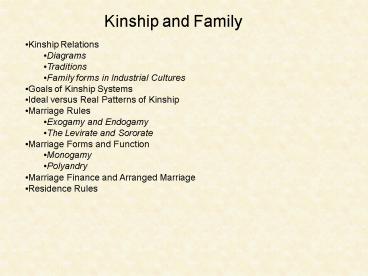Kinship and Family - PowerPoint PPT Presentation
1 / 24
Title:
Kinship and Family
Description:
Increase in divorce rate possibly brought. about by industrializing. ... Polygyny- man has more than one wife. Functions: gain status and prestige; economic ... – PowerPoint PPT presentation
Number of Views:215
Avg rating:3.0/5.0
Title: Kinship and Family
1
Kinship and Family
- Kinship Relations
- Diagrams
- Traditions
- Family forms in Industrial Cultures
- Goals of Kinship Systems
- Ideal versus Real Patterns of Kinship
- Marriage Rules
- Exogamy and Endogamy
- The Levirate and Sororate
- Marriage Forms and Function
- Monogamy
- Polyandry
- Marriage Finance and Arranged Marriage
- Residence Rules
2
Kinship Relations Diagrams
Shorthand for representing kin relations Ego-
point of reference Mother Mo Father
Fa Brother Br Sister Si Child
Ch Husband Hu Wife Wi Therefore, fathers,
brothers, son FaBrSo In-laws sister-in-law
BrWi
3
Traditional Family Form
Most enduring relationship Family of
orientation- family we are born into
(enculturation) Nuclear Family- parents and
their offspring Consanguineal relatives
(consanguine)- Blood related this can become
problematic in certain cultures like the
Trobriand Islanders Family of procreation- the
family in which you become or have the
potential to become, a parent. Affinal
relatives-relation by marriage This whole complex
system is called a kinship system Extended
Family- two or more nuclear families who are
related By blood, living in the same household,
village, or territory.
4
Kinship Diagram
5
Family Forms in Industrialized Cultures
Family Patterns Expanded family- include person
who are not kin Blended family- divorce and
remarriage Matrifocal family- mother dominate
with father present or absent Single-parent
family Why? Increase in divorce rate possibly
brought about by industrializing.
6
Goals of Kinship System
Organize groups family types residence
groups descent groups Direct
Behavior enculturation role- assigned behavior
for a particular individual Example
mother-in-law avoidance taboos Persons
status ascribed achieved Group
Security Example Yanomamö
7
Marriage Rules Exogamy and Endogamy
Exogamy- marriage outside of a designated
group Some hypotheses prevent incest Modern
genetics extend territory Endogamy- marriage
within a particular group work to maintain
cultural identity
8
How do American parents try to ensure that their
children marry the right person? We have
informal means to encourage endogamy with
regards to ethnic group origin, religion, and
socioeconomic level, and these means are
usually effective. What are they? Discuss and
compare your ideas with your Classmates.
9
Levirate and Sororate
Preferential marriage rules found in many
cultures. Provide economic protection in the
event of a spouses death. Also ensures that
the children are raised by the lineage group. Le
virate- if a womans husband dies, she should
marry one of his brothers. Sororate- if a
mans wife dies, he should marry one of her
sisters.
10
The Levirate
11
The Sororate
12
Marriage Form and Function
Marriage is an event that marks an important
transition for both parties. Cultural
Universal 1) Marriage includes an exclusive
sexual relationship between the partners. 2)
usually involves some degree in economic
interdependency including property and
labor. 3) legitimizes the couples offspring in
the eyes of the group. However, there are
exceptions. Ex. Yanomamö
13
Monogamy- one women is married to one
man Polygamy- more than one spouse Polygyny-
man has more than one wife Functions gain
status and prestige economic advantage. found
in Horticultural and Pastoral
societies Polyandry- woman has more than one
husband very rare. In fact, only 3 out of 400
cultures practice this. Ex. Tibet
14
Marriage Finance and Arranged Marriage
Bridewealth- gifts from the grooms family to the
brides family Ex Dowry- wealth brought with
the bride when she marries. Ex India
15
Residence Rules
All of the worlds cultures have customs
dictating where one lives after marriage known as
residence rules.
Neolocal residence- married couple sets up their
own household away from both sets of parents
(U.S.). Patrilocal residence- newly married
couple goes to live with the grooms father.
Ex. Yanomamö , Muslim countries. 58 of cultures
practice it. correlation with internal
warfare Matrilocal residence- newly married
couple goes to live with the brides mother.
Ex. Native American Groups (Chumash)15 of
societies correlation with external
warfare Matrifocal residence- woman and children
residing without coresidence of husband. Not a
rule Avunculocal residence- newly married
couple goes to live with the grooms mothers
brother. Ex. 3of cultures Bilocal residence-
choice 7 of cultures
16
Patrilocal residence
17
Patrilocal Residence With Second Generation
18
Yanomamö Lineage Organization
- The Yanomamö are organized into named localized
lineage groupings on the basis of patrilineal
descent. - Lineage groups are quite shallow, seldom
extending beyond two adult generations, and
small, seldom reaching as many as 100 members. - Group dimensions are limited by
- the frequent segmentation and relocation of
lineages because of internal conflicts, usually
over women, which plague larger units.
19
Yanomamö Lineage Organization Continued
- Beside fostering mutual cooperation and support
among their members, lineages function as
territorial units, inhabiting a common
settlement, and as elements of a marriage
exchange and alliance system. - They are exogamous and also consult jointly in
the selection of marriage partners for their male
and female members. - Yanomamö lineages do not take on substantial
corporate functions, such as - land ownership, that they frequently assume in
other patrilineal societies.
20
Matrilocal Residence
21
Matrilocal Residence With Second Generation
22
Avunculocal Residence
23
Avunculocal Residence With Second Generation
24
Faces of Culture Kinship and Descent
- What are the first two cultures introduced in
- the movie?
- 2) How do these cultures organize their lineage
- groups?
- 3) What problems do descent groups solve?

